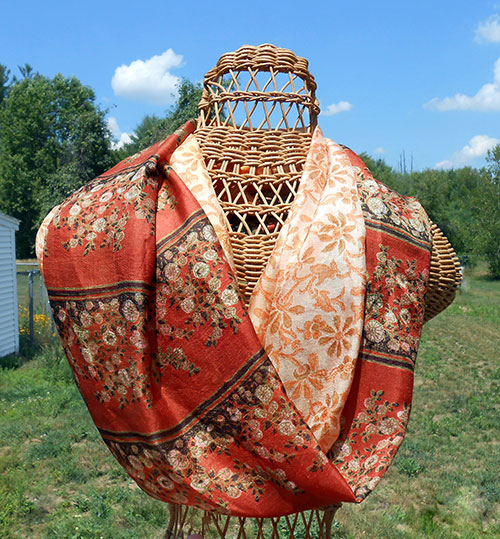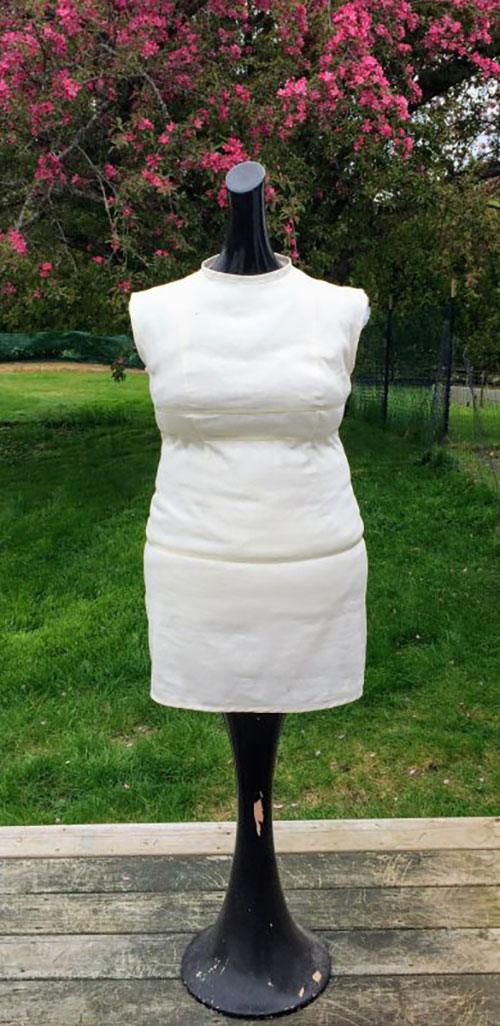How to Make a Custom Dress Form
In this post, I'll show you how to make a dress form by creating a custom-sized bodice block and padding out a mannequin. A dress form is an incredibly useful tool when you sew. Sometimes it's really difficult to get the right fit on a piece of clothing without having a body double to work with.
I've never been able to bring myself to buy a dress form because they're a bit pricey, but a couple of years ago, I got a free mannequin. Hey, who can turn down free stuff? Not me. My overstuffed craft room is evidence of that. The mannequin was not at all the same shape as me, but I knew it had potential.
Disclosure: This post contains affiliate links, which means I may receive a percentage if you make a purchase using these links. This won’t cost anything extra to you. I only link to things I like and use, and the proceeds help me to run this blog. Thank you for supporting me!
Materials used:
- Mannequin or dress form
- Check out Craigslist in your area or local thrift shops, flea markets, and antique shops. I've seen a number of dress forms and mannequins over the years.
- Fiberfill, 20-Ounce
- Mountain Mist Polyester Batting, 81-inch-by-96-inch
(2 packages)
- Gold Ribbon, 1/4-Inch Wide by 100-Yard Spool
- Double Fold Bias Tape Extra Wide 1/2in x 3 Yard Khaki
(2 packages)
- Fabric (around 2 yards)
- Bra Pad Inserts
- An old bra you don't plan to wear anymore
- Dritz Styling Design Ruler
for pattern drafting
- Swedish Tracing Paper
- Pattern Making (Portfolio Skills)
- Very comprehensive book on pattern design and bodice block construction.
- Tutorials from Angela Kane on creating a custom bodice block based on your measurements.
- This link will take you to her free video tutorials on creating a bodice block. I bought her ebooks that went along with this because they included helpful worksheets with step-by-step instructions to go with the videos. You can find the ebooks here. I bought Flat Pattern Drafting, The Basic Block, The Sleeve Block & Fitted Bodice Block eBooks and Videos for £12. It's the last item on the list in her shop. I found it helpful to have the ebooks and worksheets to go with her video series, but you can also just use the free videos.
Creating a Bodice Block
To make a dress form, the most difficult task is to first create a bodice block. A bodice block is a form-fitting sheath created to your exact measurements. It takes a bit of time and effort to do this, but once you've created a bodice block pattern for yourself, you can use it to start drafting your own sewing patterns for dresses, shirts, and skirts. So although it's a bit of work upfront, it has other useful applications as well.
There are a lot of tutorials out there on creating a bodice block. I found many of them confusing and ill-explained. The book and video tutorials that I recommended in the materials list had the best explanations I could find. I particularly liked Angela Kane's step-by-step video tutorials and ebooks/worksheets. You'll need a regular ruler or a pattern drafting ruler to create your bodice block.
Create a bodice block using your own measurements. Be sure to test the fit of your bodice block before using it. It should fit you very snugly. Make adjustments if needed to get a good fit.
I created the pattern for my bodice block on Swedish tracing paper, and then copied it onto the linen I used to make the bodice block for my dress form. This way, you have a separate copy of your bodice block for future pattern drafting.
Here's the front half of my bodice block.
When tracing my bodice block onto the linen fabric, I added lines to show the bust, waist, and hip lines. I sewed ribbon onto these lines to permanently mark them. Having these lines on your dress form can be very helpful when testing the fit on commercial sewing patterns or when draping or drafting your own pieces. I also added bias tape to enclose all raw edges.
Padding Your Mannequin
Now you can start padding to your mannequin. For the hip and waist areas, I used strips of batting, which I cut to around 8-10" wide. I wrapped them around each section until I reached the required size.
The batting sticks to itself fairly well, but I also used tape to hold it in place in some spots and to anchor it to the mannequin to begin with. Before you begin, pull out the measurements you used to make your bodice block--this will include your bust, waist, and hip measurements. Check your mannequin as you add padding to make sure that it fits these measurements.
Once you've completed the waist and hips, you can start padding the bust and upper chest. I found this was easier with smaller strips of batting--around 2-3".
For the bust, put an old bra on your mannequin and add fiberfill to round it out. The bra will compress the batting under the band, so you may need to add a little bit more padding here.
Once you add the bodice block, the batting will compress a bit, so be sure to account for that. Measure everything again to make sure it's the right size. Now you've got your custom dress form!
Addendum: Making Adjustments
I left the arms, neck, and bottom open on my bodice block, so it's easy enough to make adjustments when needed. Although I carefully measured the bust, waist, and hip lines while I was padding it, I found that the gradient between each of these points was slightly off. I also ended up adding a bit of padding to the shoulders, which I didn't fill out well enough. The bust was a bit mushy with only the bra and stuffing, so I added some bra pad inserts which worked well to fill it out more firmly. It's still not 100% perfect, but it's very close to my body, and it's much closer to my exact shape than I'd get from most dress forms. I'm sure I'll keep adjusting it as I go.
Have you tried to make a custom dress form? How did it go? Let me know in the comments!
















